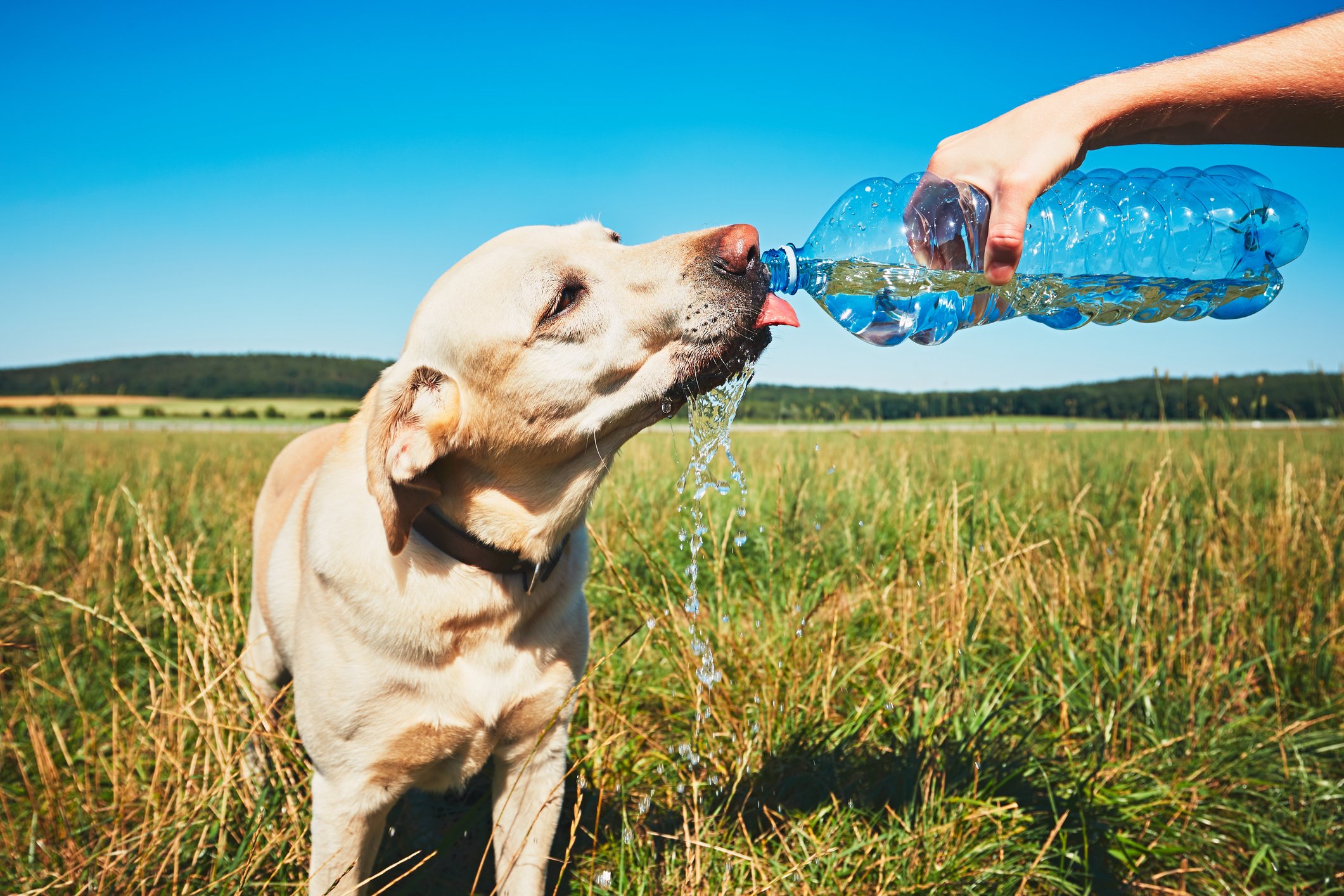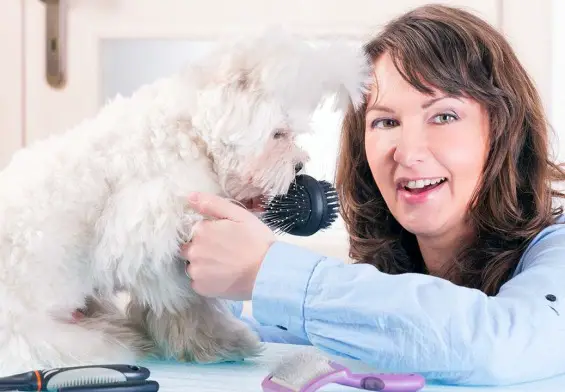How to Slow Down Dog Drinking Water So They Don’t Throw Up?
It might have been a cause of concern for you that your favorite pet is taking in water too quickly. You might have also considered the harm that might befall it should this speedy intake of water go on much longer.
You are not wrong to fear for your pet’s safety, but more importantly, wouldn’t you love to know what the problem is exactly and what you could do to remedy the situation? If you are up for the challenge, then keep reading to discover more insight.
Why Could My Dog Be Taking Water So Fast?
A very simple answer to this question would be, ‘he is thirsty, of course.’ But on a more serious note, besides thirst, there could be some other ‘invisible’ reasons why your dog has resulted in this ‘flash mode’ of drinking water.
Whatever the case might be, only a vet can expertly take one look and pinpoint the actual challenge, but that notwithstanding, here are some reasons why your dog may have been trying so much to gulp down those helpless water molecules.
A Health Condition
Diseases like; diabetics, diarrhea, liver and kidney abnormalities, e.t.c, can cause your dog to feel the need to take in water more quickly than usual.
Excessive Dehydration
Due to the prevailing weather condition, your dog might get dehydrated, and this would cause it to drink any water it finds as quickly as possible. If your dog has an infection or has done much physical activity that caused its body to run low on water, it would only be natural for it to drink any water it finds quickly.
Some signs that your dog might be dehydrated include; dried gums, unusual drowsiness, thick saliva, prolonged sleep, dried tongue e.t.c
Diet
If your dog gets to eat foods rich in salt content, then he would easily feel dehydrated and need to take a good quantity of water
Drugs Consumed
Besides illnesses, your dog could be drinking water too quickly because of the drug he had recently taken. Pills like phenobarbital, furosemide, prednisone, and the likes could heighten urine production and increase thirst. This will cause the dog to drink water too quickly.
What Could Happen If It Continues Taking Water This Way?
The likely challenges that may result from your dog drinking water too quickly are numerous, but the ones we have mentioned below are the most dangerous of all.
1. Lung Damage
Let’s draw from your own previous experience to drive home this point. The last time you swallowed a spicy meal too quickly and broke into a violent cough, how did it feel? It felt like your lungs were going to shut down, right?
The same thing happens when your dog attempts to swallow water too quickly, only for the water to go down his trachea. If this rarely occurs because your dog doesn’t take water fast, there’s nothing to worry about, but on the other hand, if it occurs repeatedly, it’s a very serious problem.
2. Canine Bloat
If you had always wondered about the second most common reason why dogs die prematurely, then there it is, canine bloat. K9 bloat occurs when a dog eats or drinks too quickly, and it is a very serious condition. This is because it does more harm than just causing your dog’s tummy to become protruded; believe it, the consequence is much more than that.
The bloat can be in any of these two forms; Gastric Dilation Volvulus and Gastric Dilation. In the former, which happens to be deadlier, the stomach gets twisted quite terribly, and if not corrected by surgery, death is imminent. On the other hand, the latter is easier to resolve; this can be done by pumping the dog’s stomach.
3. Vomiting
Because dogs cannot store much water in their stomach, they tend to vomit the water they take in when it becomes too much. For this reason, when a dog drinks water too quickly, he vomits the excess and goes back to drink more, only to vomit again.
How Do I Stop the Trend?
If you find your dog repeatedly drinking water too quickly, you can take some of the following steps to curb the defect.
1. Add Ice Cubes to The Water
Although you have to keep watching over the dog as it drinks to ensure it does not gulp down whole ice cubes, this method can be a very effective way to slow down the pace at which your dog drinks. The floating ice cubes would distract the dog from drinking too quickly.
2. Use Elevated Drinking Bowls
An elevated bowl would eliminate the need for your dog to combat gravity before it can get a refreshing drink. And, an elevated bowl would help your dog slow down while it drinks. The only drawback to this option is that your dog must have a long neck and legs that can suit the bowl’s elevated position.
3. Reduce the Quantity of Water in The Drinking Bowl
You could do this by getting a smaller slow eater bowl or, more simply, by pouring less water into the regular drinking bowl. Whichever method you choose, the goal is to get your dog to drink more slowly since the water present in the bowl is little.
However, if you wouldn’t be present with the dog for long hours, this option is not the best for you. This is because your dog could easily get dehydrated before you return to top the water in the bowl.
4. Place A Large Object in The Drinking Bowl
If you place a rock, golf ball, or baseball in the drinking water, the dog would have to slow down its drinking pace because of the obstruction provided by the object. Even if all of these are unavailable, placing a small bowl that would float within the drinking bowl could also perform the required function.
How to Know If Your Dog Is Drinking Too Much Water?
If you can observe and keep a record of your dog’s drinking habit, you can surely notice when the drinking pattern is going awol.
Place a fixed quantity of water in the drinking bowl daily, and pay attention to how much water is left in the bowl at the end of the day. Do this repeatedly over a while, and the result will be glaring.
In Normal Conditions, How Much Water Does A Dog Need?
Usually, the quantity of water needed by a dog could depend on some environmental factors, underlying health challenge, the degree of his dehydration, whether he is on medication, etc. But notwithstanding, most dogs need around 28grams of liquid for a pound of body weight daily.
Very agile dogs, nursing dogs, and newly born pups would need more than the regular 28grams. But if your dog is not within this group and drinks way more than this average volume, it might indicate an illness, for which case you would need to visit the vet.
What Are the Dangers That Could Result When A Dog Drinks Too Much Water?
When your dog continually drinks too much water, any of the following conditions could result eventually
1. Hyperhydration or Toxemia
Hyperhydration gives some warning symptoms when your dog has had too much water, often from diving, swimming, garden hose bitting, water retrieving e.t.c
Some symptoms of water intoxication include;
- convulsions
- Glazed eyes
- Loss of coordination
- vomiting
- Sluggishness
- Loss of consciousness
- Breathing difficulties
- wobbly walking
- Excessive salivation
2. Hyponatremia
This means a reduction in sodium concentration within the body due to excessive dilution by water and consequent swelling of all the body cells and organs.
3.Brain damage and Death
Uncoordinated swelling of an organ like the brain, which is encased in bones, would eventually result in seizure, coma, and death.
It is not impossible, but it may not be easy to treat hyperhydration. Even after administering the depleted ions in some severe cases, the dog’s brain may never return to normal. Thus, it is best to prevent water intoxication or seek help immediately from a vet doctor.
Some ways in which you can prevent your dog from becoming hyper hydrated are;
- Keep a small bowl of water for your dog to drink from so that he wouldn’t attempt to drink from a garden hose.
- Watch over your dog even as he plays with water from a tap or hose.
- Do not leave your dog alone with running water. A bowl of drinking water should suffice.
- Reduce the amount of time your dog gets to spend playing with water.
- Take your pet to the vet regularly to ensure it doesn’t have any underlying illnesses like kidney malfunctions, which would reduce its ability to regulate the amount of body water.
What Dogs Are at Risk for Water Intoxication?
Dog’s like Newfoundlands, Labrador, and Retrievers who have been trained to spend much time in water tend to be less susceptible to hyperhydration., While lean dogs and young puppies are most susceptible to water intoxication.
Conclusion
While staying hydrated is great even for dogs, we have already discussed the harmful effects that may result when your dog consumes too much water or when he does so too quickly.
Now that you know all these, we can conclude that you are better armed to safeguard your pooch. But if anything we have mentioned here still feels alien to you, then feel free to place a call to your vet doctor.





